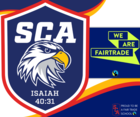SCA Secondary
Personal Mobile Device Plan
2025-26
Background
The ownership and use of a personal mobile device (PMD) has grown exponentially over the past decade. While personal devices offer potential opportunities for communication,
information access, and enhanced opportunities for instruction, personal mobile devices
can also be a source of distraction that can negatively impact children’s and student’s
mental health, engagement and learning. Regulated use of personal mobile devices in
schools and throughout the Division is required to ensure the promotion of welcoming,
caring, respectful, and safe learning and working environments. Appropriate use of
personal mobile devices contributes to the safety and security of students and staff,
minimizes risk to personal wellbeing and disruption to instruction, and protects personal
privacy and academic integrity.
Personal mobile device (PMD) is defined as any personal electronic device that can be
used to communicate with or access the internet, such as a cellphone, tablet, laptop or
smartwatch.
Use of PMDs
Junior High and High School students shall not access a PMD during instructional times
unless:
1) documentation is provided to the principal or designate that confirms the use is for
a diagnosed health or medical condition
2) documentation is provided to the principal or designate that confirms the use if for
an identified special learning need
3) given permission by the teacher for a specific educational task or purpose.
Examples of specific educational uses are:
I. Enhance learning of the classroom learner outcomes
II. BYOD (Bring Your Own Device) for educational purposes in grades 9-12
Students can access their PMD during break periods – for example, before and after
school, class breaks, and lunch breaks.
Storage of PMDs
At SCS, all devices brought to school are to be stored in a locker or backpack and either
powered off or in silent mode. PMDs shall not be on the student during class time unless documentation has been provided to the principal or designate that confirms the use is for a diagnosed health or medical condition, or an identified special learning need. PMDs may be retrieved from the storage location if teachers are having students utilize them for a specific educational purpose as outlined above.
We recommend students leave PMDs other than what is required for BYOD (Bring Your Own Device) at home. Students who choose to bring PMDs to school do so at their own risk. The security and storage of these devices is the sole responsibility of the owner or user and SCA Secondary and Elk Island Public Schools assumes no responsibility for the safety, security, loss, repair or replacement of the PMD.
General Information
Students shall not take PMDs into test or examination settings. PMDs also shall not be
used in change rooms, washrooms, private counselling rooms or any setting that has the
potential to violate a person’s reasonable expectation of privacy.
Progressive Discipline
At SCA Secondary, students will be held accountable for their behaviour and conduct as
outlined in AP 350: Student Code of Conduct. If a student uses their personal mobile
device when not permitted to do so, schools will follow disciplinary practices and
parents/guardians will be notified as outlined below.
If a student is using a personal device during instructional time, they will be asked to place the device on the teacher’s desk for the remainder of the class. If this becomes a persistent problem, teachers will reach out to parents to share the concern and notify school administration. Consequences may include, but are not limited to, school suspension. The principal or teacher will consider individual circumstances and may engage in further disciplinary action as required.
Parent/Caregiver Communication with Students
Parents are asked to refrain from contacting their child/student on their PMD during the
school day. Parents can contact the school office at 780-464-7127 who can facilitate
contact with their child/student during the school day, if needed.
